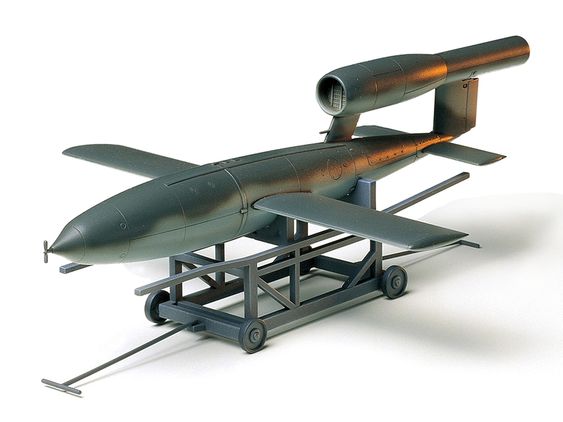V-1 Flying Bomb: The First Cruise Missile Ever made
- Development was known under the codename “Cherry Stone”
- V-1s initially had a 31 km (19 mi) diameter landing circle.
- Approximately 30,000 V-1s built

The V-1 flying bomb, sometimes referred to as the “Vengeance Weapon 1” or “Vergeltungswaffe 1” in German, was an early cruise missile. Its Fi 103 designation came from the Reich Aviation Ministry (RLM). It was also known in Germany as Kirschkern and by the Allies as the buzz bomb or doodlebug (cherry stone).
The first Vergeltungswaffen (V-weapon) used in the terror bombing of London was the V-1. It was C by the Luftwaffe at the outset of the Second World War, and during initial development was known under the codename “Cherry Stone”. The thousands of V-1 missiles fired into England from launch sites in the French (Pas-de-Calais) and Dutch coasts were limited in range.
One week after the successful Allied invasions in France, on June 13, 1944, the Wehrmacht conducted its first V-1 attack upon London. At their peak, 9,521 V-1s were shot toward southeast England per day. When the sites were taken over, the number of V-1s fired each day decreased until the last V-1 site within the range of Britain was taken by the Allies in October 1944. Afterward, the Germans launched an additional 2,448 V-1s while aiming them at Antwerp’s port and other Belgian targets. About one month before the end of the European War, on March 29, 1945, the last launch location in the Low Countries was captured.
Engine
Beginning in January 1941, the pulsejet engine of the V-1 was extensively tested on a variety of vehicles, including cars and the Tornado, an experimental attack boat. The unsuccessful version of the Sprengboot involved steering a boat filled with explosives towards the target ship while the pilot jumped out of the back at the last second. The Tornado’s small pilot house was mounted on the crossbeams and was constructed from surplus seaplane hulls that were joined in a catamaran style. The Tornado prototype was scrapped in favor of a more traditional piston-engine aircraft because it was a loud underperformer.
On April 30, 1941, the engine took flight for the first time in a Gotha Go 145.
How does V-1 Fly?
Askania in Berlin created a straightforward autopilot that the V-1 navigation system utilized to control altitude and airspeed. Yaw and pitch were managed by a pair of gyroscopes, while azimuth was kept steady using a magnetic compass. A barometer was used to maintain altitude. Two spherical tanks housed 6.2 megapascals (900 psi) of compressed air that was used to pressurize the fuel system, drive the gyros, and power the pneumatic servo motors that controlled the rudder and elevator.
The RLM initially intended to utilize the V-1 with a radio control system for pinpoint attacks, but the government ultimately chose to employ the missile against London. Several flying bombs included a simple radio transmitter that sounded between 340 and 450 kHz. The vane counter would turn on the radio once over the channel and deploy a 120-meter (400-foot) aerial. As the radio transmission ceased, an impact zone was calculated using a coded Morse signal that was specific to each V1 site and relayed the route.
When the target area was reached, it was determined using an odometer driven by a vane anemometer on the nose, which was precise enough for area bombing. It was programmed before launch to count backward from a value that, in the normal wind, would approach zero on arrival at the destination. The propeller was rotated by the airflow as the missile flew, and every 30 rotations, the odometer decremented one number. After about 60 kilometers (37 miles), this odometer caused the warhead to be armed. Two detonating bolts were fired when the count was zero.
A guillotine device severed the control hoses to the rudder servo, releasing two spoilers on the elevator, jamming the linkage between the elevator and servo, and setting the rudder in neutral. These acts caused the V-1 to drop sharply. Although a power dive was initially anticipated, in reality, the dive stopped the fuel flow, which shut down the engine. Listeners were made aware of the imminent impact by the sudden silence that followed the humming.
V-1s initially had a 31 km (19 mi) diameter landing circle, but by the conclusion of the war, accuracy had increased to roughly 11 km (7 mi), making it comparable to the V-2 rocket.
Successful operations of V-1 Flying Bomb
There were about 30,000 V-1s built; by March 1944, each one was created in 350 hours (including 120 for the autopilot), costing just 4% of a V-2 that had the same payload. 10,000 shots were fired at England, 2,419 of which made it to London, killing roughly 6,184 persons and wounding 17,981. On the southeast edge of London, Croydon, which garnered the most hits. 2,448 V-1 bombs were fired at Antwerp, Belgium, between October 1944 and March 1945.








